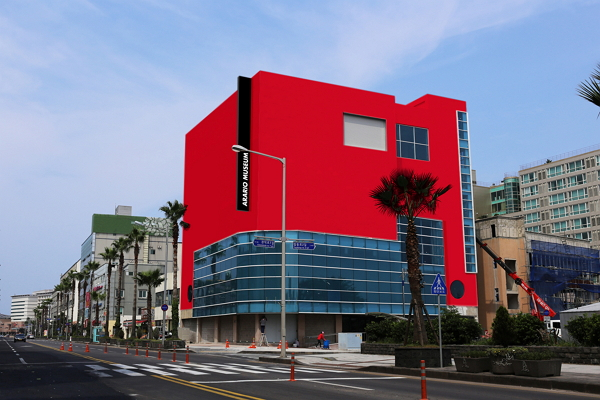Old, neglected neighborhood gets artistic touch
Arario CEO displays lifetime collection in deserted old buildings on Jejudo Island
By Lee Woo-youngPublished : Oct. 31, 2014 - 20:45
SEOUL/JEJU ― The Tap-dong area was once a bustling entertainment and shopping street in Jeju City. Located just 4 kilometers from Jeju International Airport, the neighborhood was one of the most expensive places in Jeju with movie theaters and outdoor markets drawing people from all over the island. But with the creation of a new downtown in Jeju City, the neighborhood lost its vitality and the number of visitors and residents dwindled.
Kim Chang-il, CEO of Arario Group and one of the top 200 collectors in the world, bought three deserted buildings in the district of Tap-dong a few years ago and transformed them into modern museums.
“I am going to test the power of art ― how art rejuvenates a dead neighborhood into a vibrant one,” said Kim in an interview with The Korea Herald earlier this year.
His museums house his lifetime collection of contemporary art works.
The old buildings ― the former Tapdong Cinema, Dongmun Motel and Tapdong Bikeshop ― were remodeled into museums with minimal changes to their interiors and exteriors. Kim kept the core structures of the buildings intact, revealing concrete, steel and wooden frames.
“These materials, especially concrete, make artworks stand out the most,” said Kim.
The museums showcase major artworks Kim has collected over the last 35 years. The museum in the former Tapdong Cinema, one of the most popular places for young people in Jeju from 1999 to 2005, houses overwhelming, gigantic installation works such as a huge sitting woman sculpture made of leather and eerie-looking leather portraits by Chinese artist Zhang Huan, and a wooden boat carrying a bunch of old objects by Indian artist Subodh Gupta.
Kim Chang-il, CEO of Arario Group and one of the top 200 collectors in the world, bought three deserted buildings in the district of Tap-dong a few years ago and transformed them into modern museums.
“I am going to test the power of art ― how art rejuvenates a dead neighborhood into a vibrant one,” said Kim in an interview with The Korea Herald earlier this year.
His museums house his lifetime collection of contemporary art works.
The old buildings ― the former Tapdong Cinema, Dongmun Motel and Tapdong Bikeshop ― were remodeled into museums with minimal changes to their interiors and exteriors. Kim kept the core structures of the buildings intact, revealing concrete, steel and wooden frames.
“These materials, especially concrete, make artworks stand out the most,” said Kim.
The museums showcase major artworks Kim has collected over the last 35 years. The museum in the former Tapdong Cinema, one of the most popular places for young people in Jeju from 1999 to 2005, houses overwhelming, gigantic installation works such as a huge sitting woman sculpture made of leather and eerie-looking leather portraits by Chinese artist Zhang Huan, and a wooden boat carrying a bunch of old objects by Indian artist Subodh Gupta.

Dongmun Motel, originally built in 1975, accommodates works by leading figures in contemporary art including Anthony Gormley and the Chapman brothers. Artworks sit in every motel room and bathroom under dim lighting. Viewers are often intrigued by the fact that the place was a temporary home for strangers.
“There was a red light district next to the motel,” added a staff member of the museum.
The Dongmun Motel museum will open in March next year with a focus on experimental artists.
The road from the old motel runs parallel to the narrow stream of Sanjicheon, which is undergoing a change. The stream, which used to be a major source of spring water in Jeju, was slowly polluted after factories and residential neighborhoods were constructed nearby.
The city government is currently working to restore the stream, removing the concrete structures that covered it up. Despite the changes that took place during industrial development, the basalt rocks piled along the stream and flowers growing in the rock piles have retained their natural beauty.
The four-story Tapdong Bikeshop museum, originally used as a commercial building, is devoted to the avant-garde Korean artist Kim Ku-lim, featuring his major video and installation works. It will continue to focus on his works.
The museums are open from 11 a.m. to 8 p.m. Admission costs 6,000 won for adults, 4,000 won for those between the ages of 14 and 19, and 3,000 won for those between the ages of 11 and 13. For more information, call (062) 720-8202.
By Lee Woo-young (wylee@heraldcorp.com)




![[Herald Interview] 'Amid aging population, Korea to invite more young professionals from overseas'](http://res.heraldm.com/phpwas/restmb_idxmake.php?idx=644&simg=/content/image/2024/04/24/20240424050844_0.jpg&u=20240424200058)












![[KH Explains] Korean shipbuilding stocks rally: Real growth or bubble?](http://res.heraldm.com/phpwas/restmb_idxmake.php?idx=652&simg=/content/image/2024/04/25/20240425050656_0.jpg&u=)

